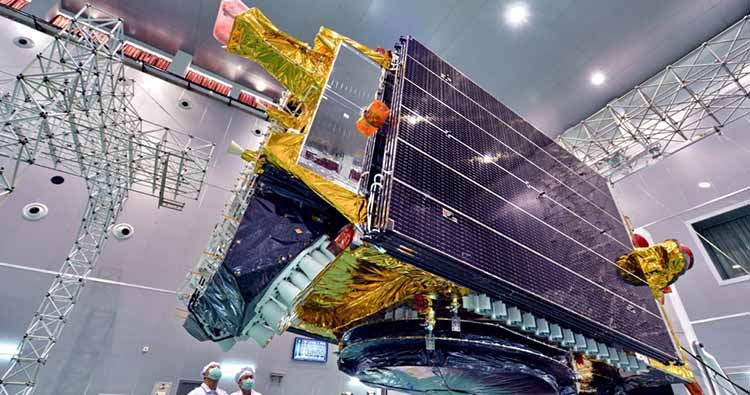Satellite technology has become a cornerstone of modern infrastructure, enabling services ranging from global communications to Earth observation and deep space exploration. In recent years, innovations in miniaturization, propulsion, artificial intelligence, and data processing have dramatically expanded the capabilities of satellite systems. Furthermore, space-based research continues to yield valuable insights in disciplines as diverse as climate science, astrophysics, medicine, and materials engineering. This article provides a comprehensive review of recent technological advances in satellite systems and explores their profound impact on scientific discovery and practical applications.
Introduction
Since the launch of Sputnik 1 in 1957, satellites have evolved from rudimentary instruments to sophisticated platforms essential to modern civilization. Today, satellites support a wide range of services, including global navigation, weather forecasting, environmental monitoring, military surveillance, and interplanetary exploration. The rapid acceleration of space technology, particularly over the last decade, has been driven by advancements in electronics, materials science, data analytics, and artificial intelligence. These developments have also facilitated a broader participation in space activities by emerging spacefaring nations, private industry, and academic institutions.

ADVANCES IN SATELLITE TECHNOLOGY
Recent advancements in satellite technology include the proliferation of Low Earth Orbit (LEO) constellations for high-speed internet access, the integration of Artificial Intelligence (AI) and Machine Learning (ML) for onboard data processing and analysis, and the development of advanced sensor technology like hyperspectral remote sensing. These advancements are transforming various sectors, from communications to environmental monitoring, and are driven by the need for more efficient, cost-effective, and adaptable satellite systems
Key Advancements:
- Proliferation of LEO Constellations:
The deployment of LEO satellite constellations, such as Starlink and Project Kuiper, aims to provide global high-speed internet access, especially in underserved areas.
- AI and ML Integration:
Integrating AI and ML into satellite systems enables onboard data processing, resource optimization, and intelligent decision-making, enhancing the efficiency and adaptability of satellites.
- Advanced Imaging and Sensor Technologies
Significant improvements have been made in multispectral, hyperspectral, and synthetic aperture radar (SAR) imaging. These systems offer sub-meter spatial resolution and greater spectral fidelity, enhancing applications in agriculture, environmental monitoring, urban planning, and national security.
SAR technology, in particular, provides high-resolution images under all weather and lighting conditions, a critical advantage for continuous Earth monitoring.

- Miniaturization and CubeSats:
One of the most significant advances in satellite technology has been the miniaturization of components, enabling the development of CubeSats and nanosatellites. These small satellites, often built in modular 10 cm³ units, can perform complex tasks such as imaging, data relaying, and scientific measurements at a fraction of the cost and development time of traditional satellites.
CubeSats have democratized access to space, allowing universities, startups, and smaller nations to participate in satellite missions. In addition, the launch of entire satellite constellations composed of small satellites enables persistent global coverage, particularly in communications and Earth observation.
- High-Throughput Communication Systems

Modern communication satellites have moved towards high-throughput satellite (HTS) architectures, which use spot beams and frequency reuse to dramatically increase data bandwidth. Innovations in Ka-band and Q/V-band technologies support higher data rates, meeting the demands of video streaming, global broadband access, and backhaul for mobile networks.
Projects like SpaceX’s Starlink, OneWeb, and Amazon’s Project Kuiper are deploying large constellations of low Earth orbit (LEO) satellites to provide low-latency, high-speed internet across the globe, including remote and underserved areas.
- Electric Propulsion and Orbit Maneuvering

Electric propulsion systems, including ion thrusters and Hall-effect thrusters, have revolutionized satellite maneuverability and mission longevity. These propulsion methods use electromagnetic fields to accelerate ions, offering a more fuel-efficient alternative to chemical thrusters.
Electric propulsion is especially beneficial for deep-space missions and geostationary satellite station-keeping, reducing launch mass and extending operational lifespans.
- Space-Based Solar Power:
The development of space-based solar power systems is gaining traction, with the potential to provide sustainable and reliable power for satellites and space missions.
- In-Space Manufacturing and Reentry Capsules:
Varda Space Industries’ W-Series capsule mission in 2024 demonstrated the potential for in-space pharmaceutical manufacturing and successful reentry of satellites, opening new avenues for space-based innovation.
- Quantum Communication:
Laser communication systems offer higher bandwidth compared to traditional radio frequencies, enhancing data transfer for deep-space missions. Quantum communication, though still experimental, promises ultra-secure satellite-based encryption.

- Autonomous Satellite Servicing:
The development of autonomous satellite servicing and space debris management technologies is crucial for maintaining the integrity of satellite constellations and ensuring their long-term sustainability.
- Additive Manufacturing
Additive manufacturing lowers the production costs of satellites and their subsystems. Satellite buses, customized payloads, and even rocket engines in satellite launchers are now 3D printed by satellite manufacturers. Startups use 3D printing on a large scale to mass-produce satellites for LEO constellations. Digital twins of bespoke and complex satellite parts are created and 3D printed. This speeds up the prototyping and testing of satellites and their parts, in turn, reducing the manufacturing lead time and costs.
Likewise, 3D printing small parts of large space structures on the ground and assembling them in space significantly reduces the complexity of space manufacturing. This saves the cargo volume and fuel required to put large structures in space. In-space additive manufacturing facilitates the replacement of malfunctioned components and enhances in-orbit satellite upgrade missions.
Isar Aerospace 3D-prints Launch Rocket Parts
German startup Isar Aerospace uses advanced additive manufacturing and carbon composite materials to manufacture rockets for launching satellites. Additive manufacturing empowers the startup to build high-performance metals with precision and provide flexibility and speed to its stakeholders. Its in-house manufactured launch vehicle, Spectrum, is already putting satellites in the SSO for up to 700 Kgs and in LEO for up to 1000 Kgs.
These advancements are shaping the future of satellite technology, making it more accessible, efficient, and capable of addressing a wide range of challenges, from connectivity and environmental monitoring to scientific research and disaster management.
Challenges and Considerations
- Space Debris and Orbital Congestion
The increasing number of satellites, particularly in LEO, raises concerns about space debris and orbital congestion. Fragmented satellites, defunct spacecraft, and spent rocket stages pose collision risks to operational missions. Initiatives like ESA’s ClearSpace-1 and NASA’s Orbital Debris Program aim to develop active debris removal systems and improved tracking.
- Regulatory and Ethical Issues
The rise of commercial space actors has outpaced the development of comprehensive space law. Key regulatory concerns include frequency spectrum allocation, orbital slot management, and data privacy. International treaties like the Outer Space Treaty (1967) provide a foundational framework, but modern challenges require updated norms and agreements.
- Data Management and Security
The deluge of data generated by satellite networks demands robust data storage, processing infrastructure, and cybersecurity protocols. Cloud computing platforms such as Amazon Web Services (AWS) and Google Cloud now support satellite data pipelines, but ensuring data integrity and secure access remains a priority.
- Launch Infrastructure and Cost
Although the cost of launching satellites has decreased due to reusable rockets like SpaceX’s Falcon 9, there are still bottlenecks related to launch availability, regulatory approvals, and insurance. Launch providers are exploring ride-share missions and dedicated small launch vehicles to increase flexibility.

The Future of Satellite Technology
- In-Orbit Servicing and Manufacturing
The ability to repair, refuel, and upgrade satellites in space is becoming a reality. Companies like Northrop Grumman and Astroscale are pioneering in-orbit servicing missions. Future developments may include in-orbit 3D printing and robotic assembly, which would significantly reduce costs and enable modular space architectures.
- Quantum and Optical Communications
Quantum communication satellites, such as China’s Micius, are exploring secure transmission through quantum key distribution (QKD). Simultaneously, optical laser communication promises to revolutionize inter-satellite and satellite-to-ground links by increasing bandwidth and reducing latency.
- Interplanetary Networks
NASA and its partners are developing lunar and Martian satellite constellations to support exploration missions, habitat construction, and surface navigation. These networks will provide critical infrastructure for sustained human presence beyond Earth.
- AI-Driven Autonomous Missions
As missions venture deeper into space, communication delays necessitate greater autonomy. AI will play a central role in spacecraft navigation, fault management, and scientific decision-making, minimizing the need for human intervention.
- Edge Computing in Space
Edge computing is being integrated into satellite systems to process data closer to its source, reducing latency and bandwidth requirements. This approach is particularly beneficial for applications like real-time Earth observation, autonomous vehicles, and disaster response. By enabling on-board data processing, satellites can deliver faster and more efficient services.
- Space-Based Internet of Things (IoT)
The integration of satellite technology with the Internet of Things (IoT) is enabling global connectivity for a myriad of devices. This development supports applications ranging from agriculture and environmental monitoring to smart cities and industrial automation. Satellite IoT solutions provide reliable connectivity in remote and underserved areas, bridging the digital divide.

SPACE BASED RESEARCH
As of mid-2025, advancements in space-based electronics research are propelling the aerospace sector into a new era of performance, autonomy, and resilience. From ultra-precise atomic clocks to AI-driven onboard computing and cutting-edge communication systems, these innovations are redefining how we design, operate, and utilize space systems.
1. FPGA-Based Neural Network Accelerators for Space Missions
Field-Programmable Gate Arrays (FPGAs) are gaining prominence in space electronics due to their adaptability and radiation tolerance. Recent research highlights their potential in accelerating onboard neural networks for tasks such as autonomous navigation, sensor data processing, and real-time decision-making. These FPGA-based accelerators offer a balance between performance and flexibility, making them suitable for the dynamic environments of space missions.
2. Terahertz (THz) Communications for Aerospace
The exploration of the THz frequency band (0.1–10 THz) is opening new frontiers in aerospace communications. THz communications promise ultra-high data rates essential for future space networks. Recent studies focus on overcoming challenges such as beam alignment, atmospheric absorption, and integration with existing communication systems. Advancements in THz technology are poised to support the growing demand for data-intensive applications in space exploration.
3. Advanced Thermal Management Systems

Effective thermal management is critical for the reliability of space electronics. Recent innovations include the development of microfluidic cooling systems, advanced heat pipes, and deployable radiators. These technologies aim to efficiently dissipate heat from high-performance electronics, ensuring optimal operation in the extreme thermal environments of space. The integration of these systems is essential for the success of future space missions.
4. Laser Communication Systems
Laser communication systems are revolutionizing data transmission in space by offering higher data rates and reduced latency compared to traditional radio frequency systems. Recent developments include the deployment of high-speed laser communication terminals on satellites and the establishment of inter-satellite links. These advancements are paving the way for more efficient and scalable communication networks in space.
5. Ultra-Precise Atomic Clocks in Space
The deployment of ultra-stable atomic clocks in space is enhancing the accuracy of timekeeping for various applications, including GPS systems and scientific research. Recent missions, such as the Atomic Clock Ensemble in Space (ACES), have installed caesium and hydrogen maser clocks on the International Space Station. These clocks provide a stable time reference, enabling precise measurements and synchronization across space-based systems.
6. Quantum Communication Systems

Quantum Key Distribution (QKD) is being explored as a method to achieve ultra-secure communication between satellites and ground stations. The European Space Agency and China’s Micius satellite have demonstrated the feasibility of QKD for secure data transmission. As quantum technologies evolve, satellites equipped with quantum communication capabilities are expected to enable global networks with unprecedented levels of security.
7. AI-Driven Onboard Processing
Artificial Intelligence (AI) is being integrated into space systems to enhance autonomy and decision-making capabilities. Recent projects involve the development of AI-driven digital twins for Earth and space observation, enabling real-time analysis and forecasting. These AI systems process vast amounts of data to provide insights into environmental conditions and support mission planning.
8. ISRO’s Advances in Electric Propulsion
The Indian Space Research Organisation (ISRO) has made significant strides in electric propulsion technologies. In March 2025, ISRO reported the successful completion of a 1,000-hour life test for its xenon-based Stationary Plasma Thruster (SPT). This advancement is expected to enhance the efficiency and payload capacity of future satellites, marking a significant milestone in India’s space capabilities.
9. Secure Satellite Communication Technologies
Ensuring secure communication in space is paramount for national security and operational integrity. Recent initiatives include the development of secure satellite communication systems by UK-based firms, supported by government funding. These systems aim to provide resilient and secure communication links, reducing reliance on non-European satellite services and enhancing national capabilities in space communication.
10. Space-Based Manufacturing of Electronics
The unique microgravity environment of space offers opportunities for manufacturing high-quality electronic components. Companies are exploring the production of semiconductor crystals and other materials in space, which can exhibit superior properties compared to those grown on Earth. These advancements could lead to the development of next-generation electronics with enhanced performance and reliability.
11. Holographic MIMO for Non-Terrestrial Networks
Holographic Multiple Input Multiple Output (HMIMO) technology is emerging as a solution for next-generation Non-Terrestrial Networks (NTNs). By utilizing compact, lightweight arrays of densely packed radiating elements with real-time reconfiguration capabilities, HMIMO can optimize system performance under dynamic conditions. This approach aims to reduce the complexity and cost of satellite manufacturing and launch, enabling more streamlined and cost-effective satellite designs.
These advancements in space-based electronics are not only enhancing the capabilities of current missions but also laying the groundwork for future exploration and utilization of space. As technology continues to evolve, these innovations will play a crucial role in shaping the next generation of space systems.
Conclusion
The advancements in satellite technology and space-based research as of 2025 are a testament to human ingenuity and collaboration. From global connectivity through satellite constellations to pioneering lunar research initiatives, the trajectory of space exploration is set to redefine our understanding and utilization of space. Continued innovation and international cooperation will be essential in addressing the challenges and harnessing the opportunities that lie ahead in the vast expanse of space.












